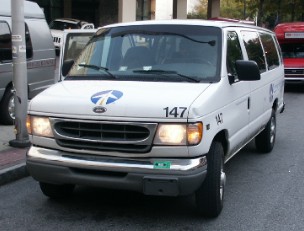 I caught a ride from Danbury to JFK in this van operated by Connecticut Limousine. The driver only drives one trip a day, but he sure knows his NY traffic.
I caught a ride from Danbury to JFK in this van operated by Connecticut Limousine. The driver only drives one trip a day, but he sure knows his NY traffic.
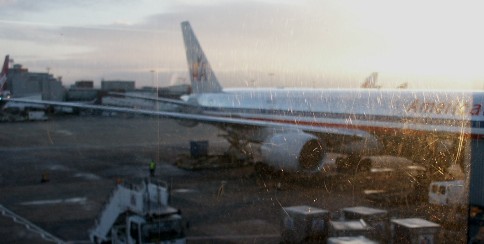 It was dark during boarding and for almost the entire flight. I caught this one and only view of my plane from a narrow window at London's Heathrow airport... unfortunately looking right into the sunlight. A nice, new (and huge) Boeing 777 from American Airlines.
It was dark during boarding and for almost the entire flight. I caught this one and only view of my plane from a narrow window at London's Heathrow airport... unfortunately looking right into the sunlight. A nice, new (and huge) Boeing 777 from American Airlines.
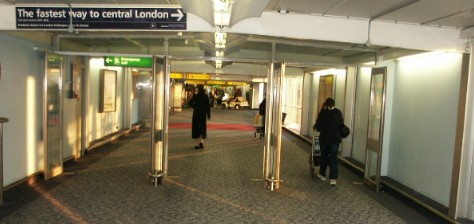 "The fastest way to central London"? I'm interested. Concourse at Heathrow, show me how to get out of here! Okay, right after showing the passport, exchanging currency, and collecting the suitcase.
"The fastest way to central London"? I'm interested. Concourse at Heathrow, show me how to get out of here! Okay, right after showing the passport, exchanging currency, and collecting the suitcase.
 The Heathrow Express station, Heathrow airport. Catch the train here, to London's Paddington Station. Takes just 15 minutes.
The Heathrow Express station, Heathrow airport. Catch the train here, to London's Paddington Station. Takes just 15 minutes.
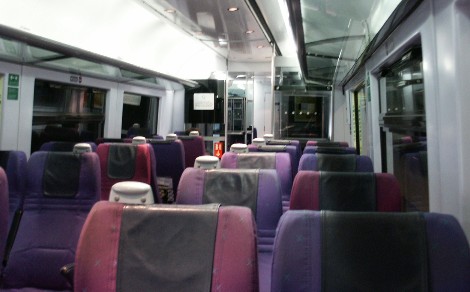 On-board the Express, very nice train!
On-board the Express, very nice train!
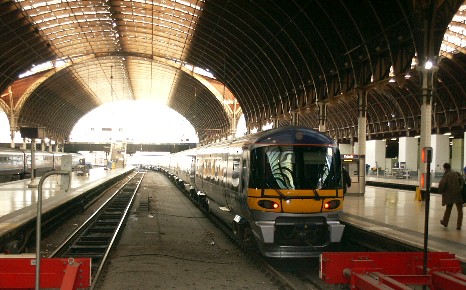 Paddington station, one of the Express trains.
Paddington station, one of the Express trains.
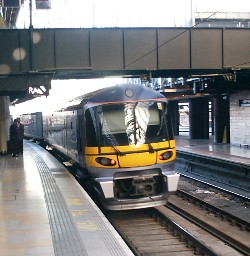 Another train, departing the station. I forgot to mention - most of the trains have OPEN DOOR buttons, both in and out, that you have to push when you want through them. I almost missed getting onboard at Heathrow. "Well, everyone else's doors opened. Why not mine? Oh! Look! What's this button?" --- DUH
Another train, departing the station. I forgot to mention - most of the trains have OPEN DOOR buttons, both in and out, that you have to push when you want through them. I almost missed getting onboard at Heathrow. "Well, everyone else's doors opened. Why not mine? Oh! Look! What's this button?" --- DUH
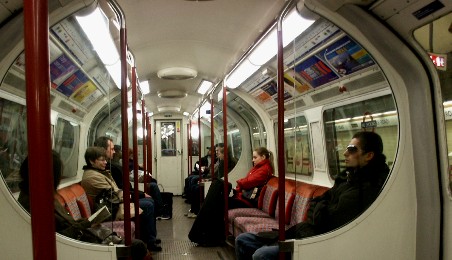 After Paddington, I connected with the London Underground, affectionately referred to as the "Tube". Very interesting designs, with sofa-cushion seats, and headroom for any six-footer only in the center 2 ft of the car. Also, when it says "Mind the Gap" while boarding the trains, they mean it. It might be a step UP 8 inches, or maybe a FOOT across the opening. Service directly from Paddington to Liverpool Street station was being re-routed for maintenance work, had to take 2 trains on different lines to get there.
After Paddington, I connected with the London Underground, affectionately referred to as the "Tube". Very interesting designs, with sofa-cushion seats, and headroom for any six-footer only in the center 2 ft of the car. Also, when it says "Mind the Gap" while boarding the trains, they mean it. It might be a step UP 8 inches, or maybe a FOOT across the opening. Service directly from Paddington to Liverpool Street station was being re-routed for maintenance work, had to take 2 trains on different lines to get there.
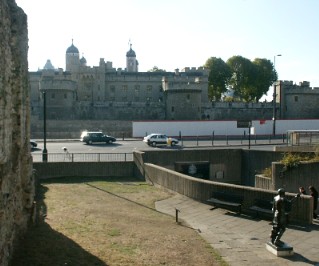 I checked my suitcase at Liverpool Street station, then went back to the Tube, to head for Greenwich. The connection is via Tower Hill and Tower Gateway stations, and you have to walk out on the surface to make the connection. Here's what you see. The Tower of London, and just to the left, part of the old London wall.
I checked my suitcase at Liverpool Street station, then went back to the Tube, to head for Greenwich. The connection is via Tower Hill and Tower Gateway stations, and you have to walk out on the surface to make the connection. Here's what you see. The Tower of London, and just to the left, part of the old London wall.
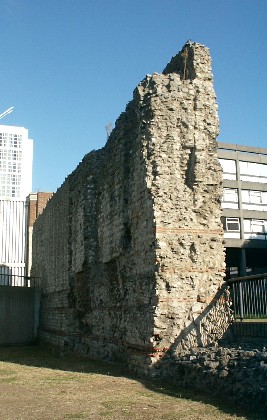 From the adjacent sign:
From the adjacent sign:
London Wall
This is one of the most impressive surviving sections of London's former city wall.
The lower part, with its characteristic tile bonding courses, was built by the Romans around 200 A.D. Its purpose may have been as much to control the passage of goods and people as for defence. Against its inner face on this side, the wall was reinforced by a substantial earth rampart. Outside was a wide ditch. In the far right hand corner, evidence of an internal turret was found in excavation. This probably contained a staircase giving access to the sentry walk. Complete with its battlements, the Roman wall would have been about 6.4 metres high.
During the medieval period, the wall was repaired and heightened. From the 17th century it fell into disuse and parts were demolished. Several sections, including this one, were preserved by being incorporated into later buildings.
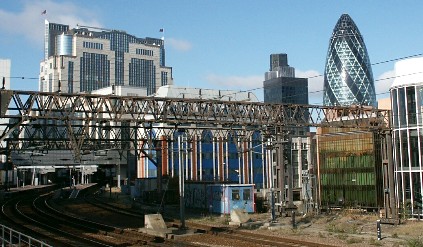 Okay, what is that thing, a building? The view from the platform of Tower Gateway station.
Okay, what is that thing, a building? The view from the platform of Tower Gateway station.
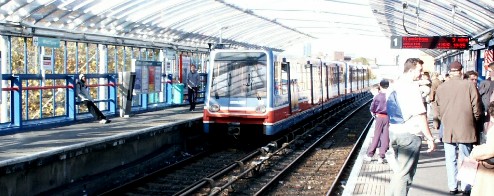 Here's what these trains look like - the Docklands Light Rail line. Four cars each train, but the front pair and the back pair are "articulated" so you can walk between them, even while they bend.
Here's what these trains look like - the Docklands Light Rail line. Four cars each train, but the front pair and the back pair are "articulated" so you can walk between them, even while they bend.
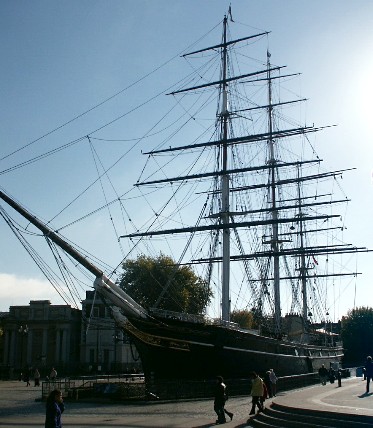 The "Cutty Sark" clipper ship. Not a lot of information is posted, she's being worked on some.
The "Cutty Sark" clipper ship. Not a lot of information is posted, she's being worked on some.
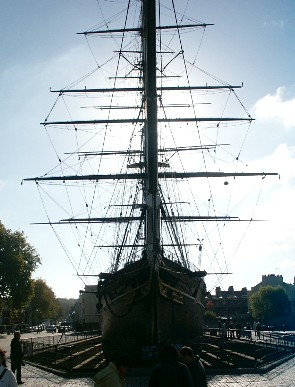 Another view of "Cutty Sark", from directly under the bow sprit... very nice rigging. I don't know how they've kept her up so well!
Another view of "Cutty Sark", from directly under the bow sprit... very nice rigging. I don't know how they've kept her up so well!
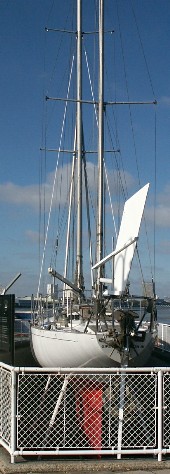 From the sign:
From the sign:
GIPSY MOTH IV (1966)
Designed by: Illingworth and Primrose, North Street, Emsworth, Hampshire.
Built by: Camper and Nicholson Ltd., Gosport, Hampshire.
Dimensions: Length - 54.0ft, Displacement - 10.4tons, Beam - 10.5ft, Sail Area - 854sq.ft, Draught - 7.75ft
Self steering gear designed by Blondie Hassler
Gipsy Moth IV was designed and built for Sir Francis Chichester in order to discover whether a fast, modern yacht, specially designed for the purpose, could be raced out to Australia and back single-handed, making passages comparable with those of the racing clippers in the Australian wool trade in the great days of sail.
Although Gipsy Moth IV did not quite achieve this target, she established records that are a credit both to the yacht's designers and to Sir Francis's tremendous driving energy. These included the fastest voyage round the world ever made by any small vessel at that time, the record for a single-hander's week's run by more than 100 miles, and a record distance of 1400 miles sailed in eight days.
Sir Francis completed his single-handed round the world voyage on 28 May 1967 in nine months and a day, covering a total distance of 29,630 miles and spending 226 days alone at sea. He celebrated his 65th birthday during the voyage.
On 7 July 1967 Sir Francis Chichester was knighted by Her Majesty The Queen at a ceremony in the grounds of the Royal Naval College, Greenwich.
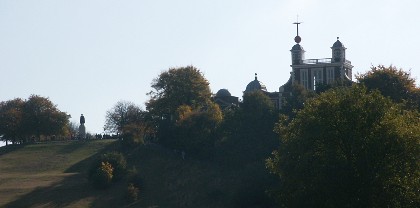 Looking up at the Royal Observatory Greenwich, or "ROG", from the patio of the National Maritime Museum.
Looking up at the Royal Observatory Greenwich, or "ROG", from the patio of the National Maritime Museum.
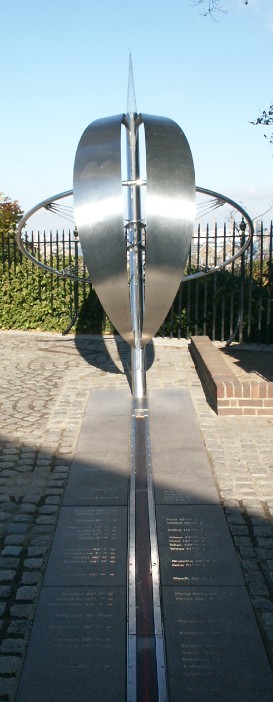 My turn to stand on the Longitude 0 Meridian, left foot in the Western Hemisphere, right foot in the Eastern. There are Longitude listings for cities on either side, engraved in the stones.
My turn to stand on the Longitude 0 Meridian, left foot in the Western Hemisphere, right foot in the Eastern. There are Longitude listings for cities on either side, engraved in the stones.
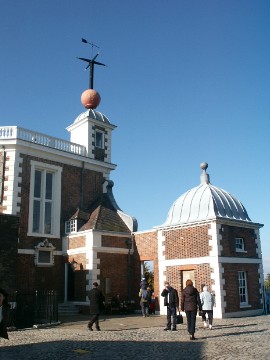 The main building, the John Harrison timekeepers are in a special exhibit on the main floor. Read "Longitude" by Dava Sobel, about this fascinating man who won the British government's Longitude prize.
The main building, the John Harrison timekeepers are in a special exhibit on the main floor. Read "Longitude" by Dava Sobel, about this fascinating man who won the British government's Longitude prize.
 H1, the first of John Harrison's clocks, photo from the National Maritime Museum site (No photography was allowed inside the museum; if it was, this page would have about twice the number of images that it does)
H1, the first of John Harrison's clocks, photo from the National Maritime Museum site (No photography was allowed inside the museum; if it was, this page would have about twice the number of images that it does)
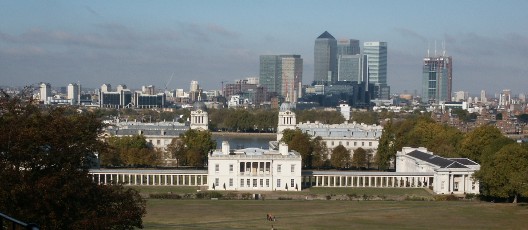 The next two pictures are meant to be side by side. This (Left) one shows the National Maritime Museum, and in the background (north of the Thames from here), the Canary Wharf corporate area. Downtown London would be off to the left, but the view was obstructed by trees.
The next two pictures are meant to be side by side. This (Left) one shows the National Maritime Museum, and in the background (north of the Thames from here), the Canary Wharf corporate area. Downtown London would be off to the left, but the view was obstructed by trees.
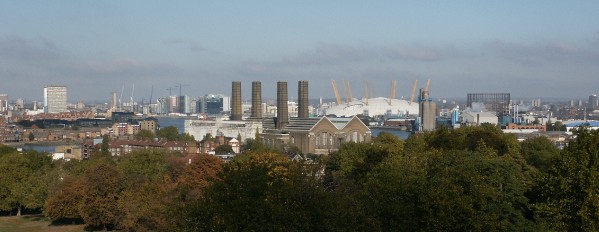 To the right, a section of SouthEast London, and I know that large exposition hall (dome) must have a name, but I haven't heard it.
To the right, a section of SouthEast London, and I know that large exposition hall (dome) must have a name, but I haven't heard it.
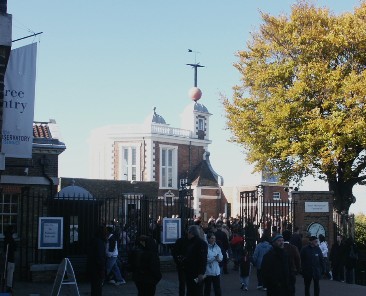 Another view of the grounds of the ROG. One of the world's oldest electric clocks, mounted to the wall on the right. It got quite a bit more crowded while I was inside.
Another view of the grounds of the ROG. One of the world's oldest electric clocks, mounted to the wall on the right. It got quite a bit more crowded while I was inside.
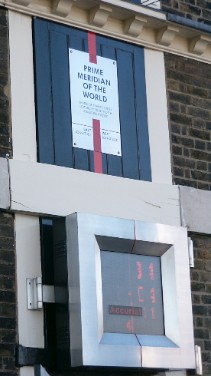 Where the "Prime Meridian of the World" meets the building, they've painted a stripe and installed a highly accurate clock that reflects Greenwich Mean Time (GMT). Set your watches. What's also interesting, but predictable, is that INSIDE this building, and right ON the meridian line, is an accurate "transit" telescope, that measures star positions as they transit (cross) the Meridian. It's still in use.
Where the "Prime Meridian of the World" meets the building, they've painted a stripe and installed a highly accurate clock that reflects Greenwich Mean Time (GMT). Set your watches. What's also interesting, but predictable, is that INSIDE this building, and right ON the meridian line, is an accurate "transit" telescope, that measures star positions as they transit (cross) the Meridian. It's still in use.
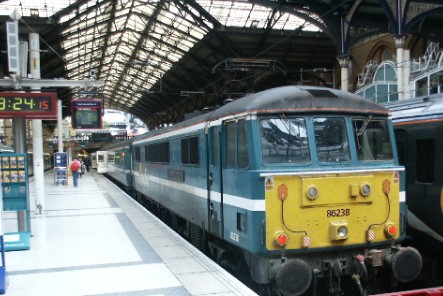 Finally, I was too tired to stay out in tourist mode - had to head for my accomodations. I rode back to Liverpool Street station, and booked a ticket on Anglia Railway's train to Ipswich. I know, it's kinda ugly - but it is VERY FAST. I'd guess we topped 100 most of the trip.
Finally, I was too tired to stay out in tourist mode - had to head for my accomodations. I rode back to Liverpool Street station, and booked a ticket on Anglia Railway's train to Ipswich. I know, it's kinda ugly - but it is VERY FAST. I'd guess we topped 100 most of the trip.